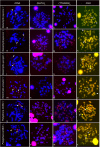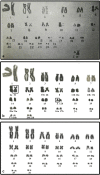Turtles of the genera Geoemyda and Pangshura (Testudines: Geoemydidae) lack differentiated sex chromosomes: the end of a 40-year error cascade for Pangshura
- PMID: 30755825
- PMCID: PMC6368832
- DOI: 10.7717/peerj.6241
Turtles of the genera Geoemyda and Pangshura (Testudines: Geoemydidae) lack differentiated sex chromosomes: the end of a 40-year error cascade for Pangshura
Abstract
For a long time, turtles of the family Geoemydidae have been considered exceptional because representatives of this family were thought to possess a wide variety of sex determination systems. In the present study, we cytogenetically studied Geoemyda spengleri and G. japonica and re-examined the putative presence of sex chromosomes in Pangshura smithii. Karyotypes were examined by assessing the occurrence of constitutive heterochromatin, by comparative genome hybridization and in situ hybridization with repetitive motifs, which are often accumulated on differentiated sex chromosomes in reptiles. We found similar karyotypes, similar distributions of constitutive heterochromatin and a similar topology of tested repetitive motifs for all three species. We did not detect differentiated sex chromosomes in any of the species. For P. smithii, a ZZ/ZW sex determination system, with differentiated sex chromosomes, was described more than 40 years ago, but this finding has never been re-examined and was cited in all reviews of sex determination in reptiles. Here, we show that the identification of sex chromosomes in the original report was based on the erroneous pairing of chromosomes in the karyogram, causing over decades an error cascade regarding the inferences derived from the putative existence of female heterogamety in geoemydid turtles.
Keywords: Comparative genome hybridization; Evolution; FISH; Karyotype; Microsatellite; Sex chromosomes; Sex determination; Telomeres; Turtles.
Conflict of interest statement
The authors declare that they have no competing interests.
Figures




Similar articles
-
Cytogenetic Analysis of the Asian Box Turtles of the Genus Cuora (Testudines, Geoemydidae).Genes (Basel). 2021 Jan 25;12(2):156. doi: 10.3390/genes12020156. Genes (Basel). 2021. PMID: 33503936 Free PMC article.
-
Sex is determined by XX/XY sex chromosomes in Australasian side-necked turtles (Testudines: Chelidae).Sci Rep. 2020 Mar 9;10(1):4276. doi: 10.1038/s41598-020-61116-w. Sci Rep. 2020. PMID: 32152354 Free PMC article.
-
ZZ/ZW Sex Determination with Multiple Neo-Sex Chromosomes is Common in Madagascan Chameleons of the Genus Furcifer (Reptilia: Chamaeleonidae).Genes (Basel). 2019 Dec 6;10(12):1020. doi: 10.3390/genes10121020. Genes (Basel). 2019. PMID: 31817782 Free PMC article.
-
Sex chromosomes, sex-linked genes, and sex determination in the vertebrate class amphibia.EXS. 2001;(91):143-76. doi: 10.1007/978-3-0348-7781-7_8. EXS. 2001. PMID: 11301597 Review.
-
The evolution of sex chromosomes and sex determination in vertebrates and the key role of DMRT1.Sex Dev. 2007;1(1):2-11. doi: 10.1159/000096234. Sex Dev. 2007. PMID: 18391511 Review.
Cited by
-
Heterochromatin and microsatellites detection in karyotypes of four sea turtle species: Interspecific chromosomal differences.Genet Mol Biol. 2020 Dec 2;43(4):e20200213. doi: 10.1590/1678-4685-GMB-2020-0213. eCollection 2020. Genet Mol Biol. 2020. PMID: 33270075 Free PMC article.
-
Interstitial Telomeric Repeats Are Rare in Turtles.Genes (Basel). 2020 Jun 16;11(6):657. doi: 10.3390/genes11060657. Genes (Basel). 2020. PMID: 32560114 Free PMC article.
-
Poorly differentiated XX/XY sex chromosomes are widely shared across skink radiation.Proc Biol Sci. 2021 Jan 27;288(1943):20202139. doi: 10.1098/rspb.2020.2139. Epub 2021 Jan 20. Proc Biol Sci. 2021. PMID: 33468012 Free PMC article.
-
Cross-Species BAC Mapping Highlights Conservation of Chromosome Synteny across Dragon Lizards (Squamata: Agamidae).Genes (Basel). 2020 Jun 25;11(6):698. doi: 10.3390/genes11060698. Genes (Basel). 2020. PMID: 32630412 Free PMC article.
-
Little evidence for switches to environmental sex determination and turnover of sex chromosomes in lacertid lizards.Sci Rep. 2019 May 24;9(1):7832. doi: 10.1038/s41598-019-44192-5. Sci Rep. 2019. PMID: 31127134 Free PMC article.
References
-
- Altmanová M, Rovatsos M, Kratochvíl L, Johnson Pokorná M. Minute Y chromosomes and karyotype evolution in Madagascan iguanas (Squamata: Iguania: Opluridae) Biological Journal of the Linnean Society. 2016;118(3):618–633. doi: 10.1111/bij.12751. - DOI
LinkOut - more resources
Full Text Sources

